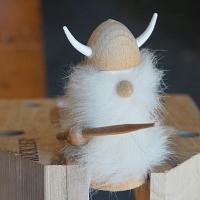
Mike40
in over 11 years
MAKING A WOODEN GEARED CLOCK #9: Gluing up and Trial Assembly - Day 9
This is
part 9
in a
9 part
series:
MAKING A WOODEN GEARED CLOCK
...
-
The Main Weight and Finishing Up Details - Day 8
-
Gluing up and Trial Assembly - Day 9
- The Main Weight and Finishing Up Details - Day 8
- Gluing up and Trial Assembly - Day 9
Day 9 work
The different parts were glued up, namely;
- the 3 piece main frame
- the 5 piece winding wheel (5 wheels glued together to form a pulley like part)
- various wheel spacers onto the wheel arbors
- 3 pinion gears onto the wheels
- the coopered main weight and the counter weight/handle.
The weights glued up
The long weight will contain about 2.4kg (a little over 5lbs) of lead pellets. I bought these in 1kg bags from a divers supply store. This weight drives the clock and the attached cord is wound around the winding wheel.
The smaller counter weight will be left hollow as only a small amount of weight is necessary. It has two functions (1) as a light counter weight to hold the cord taut. The other end of the cord is attached to the main weight. (2) the counter weight also functions as a handle to rewind the clock. This is done by simply pulling down on the handle which in turn raises the main weight. Most clocks of this type use a winding key for this function, but the handle is quicker and simpler.
This was the first version of these weights. I had to modify them slightly later on. I will explain why in another blog.
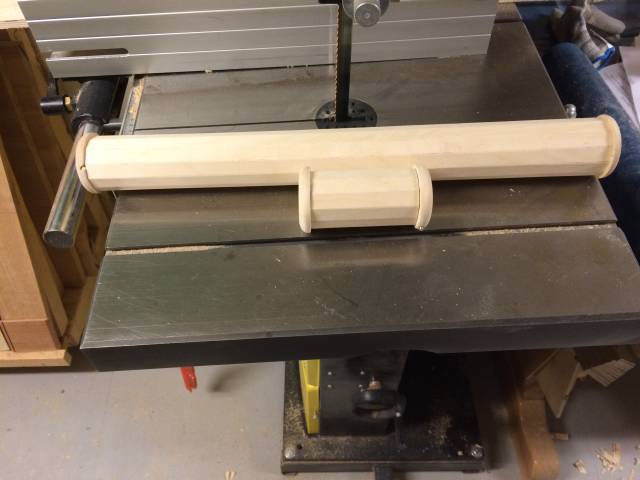
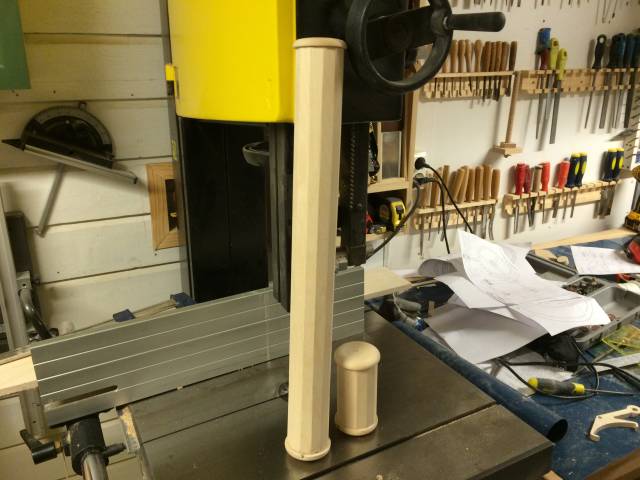
the arbors were all polished (wheel axles) before inserting them into the frame . I also ran the winding wheel on my disk sander jig, first to get the smaller diameter inside wheels round and then again after gluing all 5 disks together to get the outside larger diameter wheels round and balanced.
Test assembly and problem Areas
I temporarily mounted the wheels to see if the teeth would match up perfectly. They didn’t. This was due to two potential problems:
- The plan called for 6.5mm ply for the three main wheels and I could only get 6mm ply. So an accumulated difference of 3mm putting the final hour dial too far out.
- I might have made the hub cap on the back of the winding wheel too thick.
Potential solutions
- Extra washers to move the wheels outwards
- Removal of some material on the back of the winding wheel which would have the effect of moving the hour dial in towards the back
- Change the height of the various arbor spacers
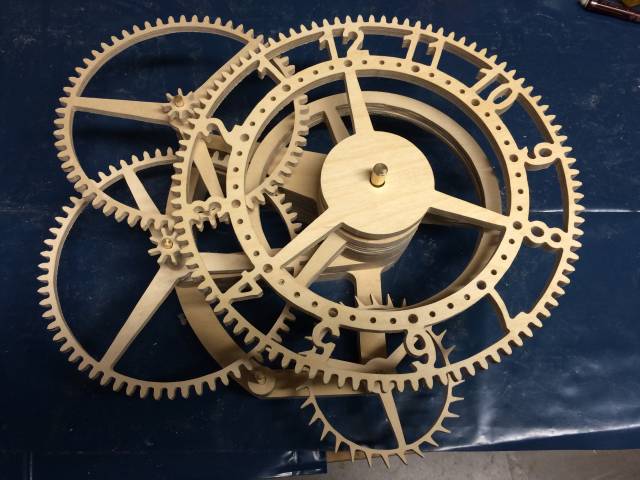
Part of the realityof a project like this is that some problems will almost certainly be encountered. Great disappointment and frustration can be one outcome. On the other hand a lot can be learned from the work involved in finding solutions to the problems. It is a choice to decide which of these two ways to approach it. I’m going for the latter.
Thanks for reading!
Mike, an American living in Norway
13 Comments
Incredible! Really looks great. I’m sure you’ll sort out the mechanical issues and get it running like a Swiss watch.
Losing fingers since 1969
OK Mike: So what time is it? I hope Beer time!!
-Madts.
Tor and Odin are the greatest of gods.
Thanks Brian. You mean like this Madts?
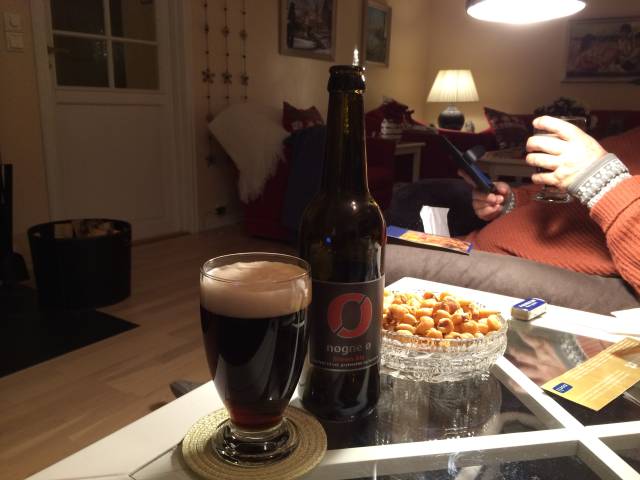
Mike, an American living in Norway
I think that cuts the mustard.
-Madts.
Tor and Odin are the greatest of gods.
I think that cuts the mustard.
-Madts.
Tor and Odin are the greatest of gods.
It’s beer:30!!
Losing fingers since 1969
looking real good , I know you will solve the problems and get it going . Can’t wait to see he finished clock.
/
Wheaties
I had originally intended to veneer the 6mm ply to bring it up to 6.5mm, but I decided to try a different tact because veneering would have meant doing the front and the back and also sanding down either the ply before veneering, or sanding the veneers. Sanding the ply would probably be best.
I have a drum sander, so not too difficult, but I didn’t have enough large veneers that I thought would look good on this clock plus about 90% of it would be waste after cutting. Perhaps a bad decision, but if I can get the clock going without veneering I will have gained some useful experience and also save myself a lot of extra work and expense.
If my plan doesn’t work out, then I am prepared to do the veneering anyway and recut the 6.5mm thick wheels. This is, after all, a learning project for me and I’m sure I will learn a lot from it whether positive or negative.
Mike, an American living in Norway
I’m a little confused ,if it is all made from the same thickness material it souldn’t mater , right ? Wrong ?
Wheaties
Looking good Mike!
Abbas, Castro Valley, CA
Bruce Several different thicknesses actually.
Mike, an American living in Norway
I understand now.
Wheaties
WOW!!! I am SO impressed!!
Keith "Shin" Schindler










